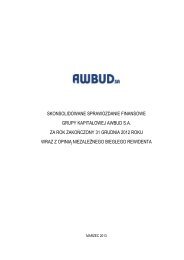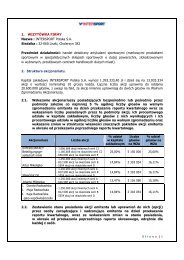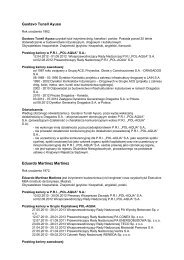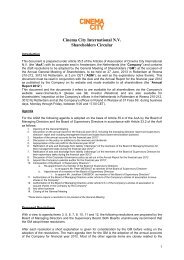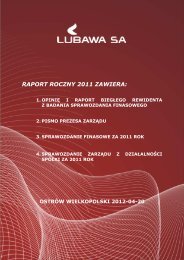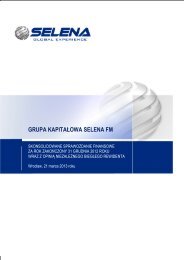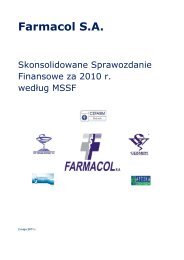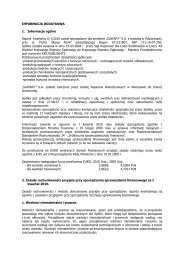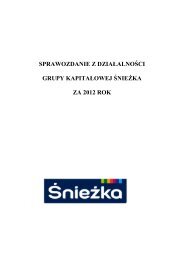We had already been - Notowania
We had already been - Notowania
We had already been - Notowania
You also want an ePaper? Increase the reach of your titles
YUMPU automatically turns print PDFs into web optimized ePapers that Google loves.
Report on Operations<br />
Group Results<br />
Macroeconomic situation, banking and financial markets<br />
International Situation<br />
USA/Eurozone<br />
The end of 2009 appears to have halted the free fall in economic<br />
activity seen at the beginning of the year. In fact, the rebound in<br />
world trade helped major economies pull out of the recession.<br />
However, while on the one hand, the global recovery is under way<br />
and the risks of falling back into a recession are rather limited, in the<br />
last quarter of the year, growth seems to have lost steam, since at<br />
least a part of the temporary factors underlying recent improvement<br />
in the global economy are losing their effect. In major developed<br />
economies (USA, Eurozone, UK and Japan), signs of “endogenous”<br />
growth are still scarce, and prospects for consumption and<br />
investments remain subdued.<br />
Despite improvement in the last two quarters, the overall<br />
situation is characterized by weak private demand: after having<br />
collapsed at the turn of the year, it impacted hevily on the growth<br />
performance for the whole 2009: in the US, GDP contracted 2.5%,<br />
and it declined 4% in the Eurozone, while Japan reported a more<br />
substantial decrease of 5.3%.<br />
In the Eurozone, net exports and the rebuilding of inventories were<br />
the main factors that led to the recent improvement in economic<br />
growth. In fact, the summer break brought good news on the exports<br />
side: the world economy saw a rebound in global trade, which after<br />
dropping to all-time lows following the Lehman Brothers collapse<br />
was up thanks to highly expansive fiscal and monetary policies<br />
implemented by governments and central banks. Asian countries,<br />
particularly China, were the first to show signs of recovery and to<br />
provide the greatest push to the growth in trade, followed by the US<br />
and the Eurozone. In Q3 2009, eurozone exports rose by 3.1% on<br />
a quarterly basis, while imports were up by 3%. Annual changes in<br />
these components are still negative, but better than those in previous<br />
quarters (-13.5% in Q3 compared to -17.2% in Q2 for exports;<br />
-11.8% in Q3 compared to -14.3% in Q2 for imports). It should also<br />
be noted that an encouraging feature of this recovery is the high<br />
level of synchronization, increasing the chances that signs of growth<br />
will strengthen globally in succession.<br />
The second factor that seems to have played a significant role in<br />
the recent recovery was the rebuilding of inventories: following the<br />
crisis and the unprecedented drop in demand, firms decided to<br />
slash their production and satisfy their demand out of inventories,<br />
which dropped consequently. In recent months, as a direct result of<br />
the extremely low level of inventories, it is likely that a swift upward<br />
adjustment in production occurred, aimed at satisfying further<br />
increases in external demand.<br />
Investment remained the weak spot in this fragile economic situation,<br />
continuing the downward trend of some two years in the Eurozone<br />
36 2009 Consolidated Reports and Accounts · UniCredit Group<br />
(-0.7% in 2008 and -10.8% in 2009) and in Japan (-1.6% in 2008<br />
and -19.3% in 2009), while in the US the drop was significant,<br />
especially in 2009 (-17.8%) after moderate growth in 2008 (1.8%).<br />
Firms are still having a hard time resuming capital expenditure, and<br />
this difficulty will continue for all of 2010.<br />
However, indicators of economic activity from business confidence<br />
surveys keep signaling a rather sustained momentum. After<br />
collapsing to historical lows at an unprecedented speed, business<br />
confidence surveys have resumed growing, and have returned to<br />
levels consistent with expansion in economic activity, following<br />
widespread improvement in all components. The most significant<br />
improvements were especially reported in new order components,<br />
which, in the Eurozone, returned to the levels prior to the economic<br />
crisis. As regards the PMI manufacturing index, in October 2009 it<br />
moved into an expansionary territory, and in December stood at 51.6,<br />
which is a long way from the low of 33.5 reported in February 2009.<br />
Similarly, in the US the ISM manufacturing index rose from 35.6 in<br />
January 2009 to 55.9 in December.<br />
Clearly, the crisis also <strong>had</strong> a major impact on labor market<br />
conditions. The widespread reduction in manufacturing resulted in<br />
a sharp reduction in jobs. In 2009, the US economy lost a total of<br />
4.7 million jobs (compared to 3.8 million in 2008). The decline was<br />
significant and led to a considerable increase in the unemployment<br />
rate, which hit 10%. In the Eurozone, the labor market showed<br />
greater resilience due in part to employment support schemes that<br />
limited job losses. Furthermore, even though the labor market is<br />
experiencing the first tentative signs of improvement, the major<br />
risk is that it will remain weak for most of 2010 due to the heavy<br />
underutilization of the labor force.<br />
In terms of prices after remaining in negative territory for five months<br />
(from June to October 2009), in November inflation (the HICP index)<br />
in the Eurozone returned in positive territory figure (+0.5%) and<br />
was up by 0.9% in December due to an unfavorable base effect on<br />
energy prices (in fact, at the end of 2008, oil prices were in free fall).<br />
On the other hand, after providing a significant contribution to the<br />
decline in total inflation at the beginning of the year, in the second<br />
half of the year inflation of food products continued on a downward<br />
trend.<br />
As for monetary policy, after bringing the refi rate to 1.00%, the<br />
European Central Bank (ECB) took several steps to provide an<br />
effective resolution of the financial crisis and to support the real<br />
economy by buying covered bonds and extending cash refinancing<br />
operations for banks in order to revitalize one of the markets most<br />
heavily hit by the financial crisis and to reopen a significant source of<br />
financing for the banking industry.<br />
In the US, after reducing the Fed Funds rate to an all-time low<br />
(in a range of 0 to 0.25%), the Federal Reserve implemented a



